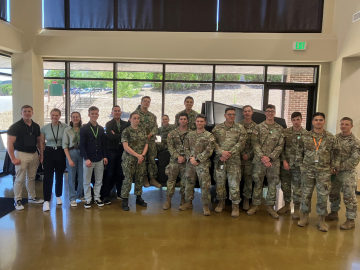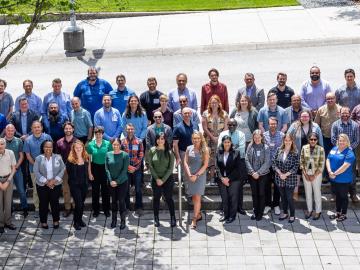
Filter News
Area of Research
- Advanced Manufacturing (8)
- Biology and Environment (52)
- Biology and Soft Matter (1)
- Clean Energy (67)
- Climate and Environmental Systems (2)
- Computational Engineering (1)
- Computer Science (4)
- Electricity and Smart Grid (1)
- Fuel Cycle Science and Technology (2)
- Functional Materials for Energy (1)
- Fusion and Fission (31)
- Fusion Energy (11)
- Isotope Development and Production (1)
- Isotopes (26)
- Materials (109)
- Materials Characterization (1)
- Materials for Computing (18)
- Materials Under Extremes (1)
- Mathematics (1)
- National Security (52)
- Neutron Science (34)
- Nuclear Science and Technology (38)
- Nuclear Systems Modeling, Simulation and Validation (1)
- Quantum information Science (9)
- Supercomputing (96)
- Transportation Systems (1)
News Topics
- (-) Climate Change (104)
- (-) Cybersecurity (35)
- (-) Frontier (44)
- (-) Isotopes (55)
- (-) Materials Science (145)
- (-) National Security (71)
- (-) Nuclear Energy (110)
- (-) Quantum Computing (37)
- (-) Quantum Science (71)
- (-) Space Exploration (25)
- 3-D Printing/Advanced Manufacturing (125)
- Advanced Reactors (34)
- Artificial Intelligence (97)
- Big Data (60)
- Bioenergy (92)
- Biology (100)
- Biomedical (60)
- Biotechnology (23)
- Buildings (61)
- Chemical Sciences (70)
- Clean Water (31)
- Composites (29)
- Computer Science (195)
- Coronavirus (46)
- Critical Materials (29)
- Decarbonization (82)
- Education (4)
- Element Discovery (1)
- Emergency (2)
- Energy Storage (112)
- Environment (198)
- Exascale Computing (40)
- Fossil Energy (6)
- Fusion (57)
- Grid (66)
- High-Performance Computing (90)
- Hydropower (11)
- Irradiation (3)
- ITER (7)
- Machine Learning (49)
- Materials (145)
- Mathematics (9)
- Mercury (12)
- Microelectronics (4)
- Microscopy (51)
- Molten Salt (8)
- Nanotechnology (60)
- Net Zero (14)
- Neutron Science (134)
- Partnerships (49)
- Physics (63)
- Polymers (33)
- Renewable Energy (2)
- Security (25)
- Simulation (49)
- Software (1)
- Statistics (3)
- Summit (59)
- Sustainable Energy (130)
- Transformational Challenge Reactor (7)
- Transportation (97)
Media Contacts

At ORNL, a group of scientists used neutron scattering techniques to investigate a relatively new functional material called a Weyl semimetal. These Weyl fermions move very quickly in a material and can carry electrical charge at room temperature. Scientists think that Weyl semimetals, if used in future electronics, could allow electricity to flow more efficiently and enable more energy-efficient computers and other electronic devices.

Benjamin Manard, an analytical chemist in the Chemical Sciences Division of the Department of Energy’s Oak Ridge National Laboratory, will receive the 2024 Lester W. Strock Award from the Society of Applied Spectroscopy.

Ten future U.S. Army officers recently visited ORNL to learn about the legacy of nuclear science. As students of the Nuclear Science and Engineering Research Center, or NSERC, with the Defense Threat Reduction Agency, or DTRA, they stopped in East Tennessee as part of a larger tour across nuclear facilities supporting the military. In Oak Ridge, they visited ORNL to gain an appreciation of the history of the Manhattan Project and how research at a national lab contributes new materials and electronics for the nuclear industry.

Seven entrepreneurs comprise the next cohort of Innovation Crossroads, a DOE Lab-Embedded Entrepreneurship Program node based at ORNL. The program provides energy-related startup founders from across the nation with access to ORNL’s unique scientific resources and capabilities, as well as connect them with experts, mentors and networks to accelerate their efforts to take their world-changing ideas to the marketplace.

The world’s fastest supercomputer helped researchers simulate synthesizing a material harder and tougher than a diamond — or any other substance on Earth. The study used Frontier to predict the likeliest strategy to synthesize such a material, thought to exist so far only within the interiors of giant exoplanets, or planets beyond our solar system.
Joe Tuccillo, a human geography research scientist, leads the UrbanPop project that uses census data to create synthetic populations. Using a Python software suite called Likeness on ORNL’s high-performance computers, Tuccillo’s team generates a population with individual ‘agents’ designed to represent people that interact with other agents, facilities and services in a simulated neighborhood.
The contract will be awarded to develop the newest high-performance computing system at the Oak Ridge Leadership Computing Facility.

ORNL hosted the Mid-South Regional Chapter of the American Society for Photogrammetry and Remote Sensing, or ASPRS. Participants spanning government, academia and industry engaged in talks, poster sessions, events and workshops to further scientific discovery in a field devoted to using pictures to understand changes to the earth’s inhabitants and landscape.

To better predict long-term flooding risk, scientists at the Department of Energy’s Oak Ridge National Laboratory developed a 3D modeling framework that captures the complex dynamics of water as it flows across the landscape. The framework seeks to provide valuable insights into which communities are most vulnerable as the climate changes, and was developed for a project that’s assessing climate risk and mitigation pathways for an urban area along the Southeast Texas coast.

Researchers conduct largest, most accurate molecular dynamics simulations to date of two million correlated electrons using Frontier, the world’s fastest supercomputer. The simulation, which exceed an exaflop using full double precision, is 1,000 times greater in size and speed than any quantum chemistry simulation of it's kind.


